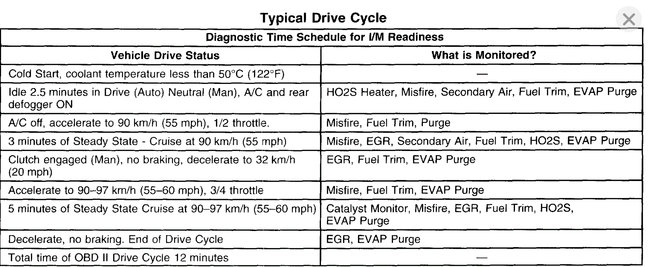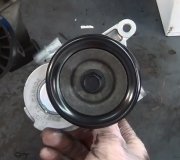To add to what Joe posted. Some of the monitors take very specific conditions to run. For instance the EVAP tests will normally only run with the tank between.25 and.75 full and with the coolant temperature close to the outside air temperatures.
This is the EVAP Drive cycle on your Camaro -
The barometric pressure is more than 75 kPa.
The fuel level is between 1/4 and 3/4 full.
The battery voltage is between 10-18 volts.
The test will initiate only after a cold start. If the following conditions are met, the control module considers the engine to be cold:
- The engine coolant temperature (ECT) is between 3.75-30°C (39-86°F).
- The intake air temperature (IAT) is between 3.75-30°C (39-86°F).
- The difference between the ECT and the IAT is less than 8°C (14°F).
Next would be the O2 sensor heaters
The start-up engine coolant temperature (ECT) is less than 50°C (122°F).
The start-up intake air temperature (IAT) is less than 50°C (122°F).
The difference between the IAT and the ECT is less than 8°C (14°F).
The battery voltage is between 11-18 volts.
This is for the secondary Air Injection-
Passive Test
The engine coolant temperature (ECT) is between 70-110°C (158-230°F).
The intake air temperature (IAT) is between 2-100°C (36-212°F).
The battery voltage is more than 11.7 volts.
The Active Test, if required, begins after the engine goes into Closed Loop Fuel Control.
The engine coolant temperature (ECT) is between 70-110°C (158-230°F).
The intake air temperature (IAT) is more than 2°C (36°F).
The engine is operating in Closed Loop Fuel Control.
The battery voltage is more than 11.7 volts.
This is the Catalyst test -
The barometric pressure is more than 74 kPa.
Engine coolant is at the operating temperature, 71-120°C (160-248°F).
The intake air temperature (IAT) is between -15 to +75°C (5-167°F).
The engine is in Closed Loop Fuel Control.
The engine has run for 6-8 minutes off idle in order to initiate the test.
The battery voltage is between 11-18 volts.
In theory these should run and set from a cold start, however some can be a big headache to get them run, plus it is possible that a code or mechanical issue that doesn't turn on the CEL could cause one or more to fail to run. Note those EVAP cold start temperatures. See that the test doesn't run if the temperature is over 86 degrees or so? So if you're in a desert area with normal temperatures at 90 plus degrees daily, it could take a while for that one to run. That is why most states have an allowance for an unset monitor on older vehicles.
It is also why GM added the service bay test on the scan tool, It allows the test to run with higher temperature thresholds for those hard test areas.
Sunday, March 29th, 2020 AT 10:06 PM




